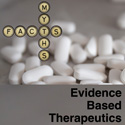Episode 5: Swiss Cheese & The Evidence Holes in the Lipid Hypothesis
In our fifth installment, we end our discussion of cholesterol outlining some of the remaining evidence gaps. Areas discussed are primary prevention for women, the use of other cholesterol reducing medicines, and the need for follow-up cholesterol testing for patients on statins. We avoid filling the evidence gaps with theory-based assumptions and close by discussing the endless fun in tests, doctors’ visits and taking medicines.
Show Notes
1) Absolute benefit of statins over approx 5 years
| Major coronary events (%)* | Death (%) | Strokes (%) | FROM WHAT CVD TO WHAT CVD (%) | |
| Primary | 1-1.5* | – | – | 8-9 to 7 |
| Diabetes | 2 | – | 1-1.5 | 10 to 7 |
| Secondary | 4 | 2 | 1 | 20 to 15 |
* just in males and NO difference in overall serious adverse events
2) Meta-analysis data for mortality benefit with Statins in primary prevention
- TI meta-analysis on statins in women for primary prevention.
- “For women without cardiovascular disease, lipid lowering does not affect total or CHD mortality. Lipid lowering may reduce CHD events, but current evidence is insufficient to determine this conclusively.” JAMA 2004;291:2243-52
3) Ezetrol data
4) Fibrate data
- Helsinki Heart StudyNEJM 1987;317:1237-45
- FIELD study – fenofibrate for type 2 diabetics – no reduction in coronary eventsLancet 2005;366:1849-61
- Statistical increases in mortality from causes other than cardiovascular disease- approximately 0.75% increase in non-cardiovascular mortality. Arch Intern Med 2005;165:725-30 Am Heart J 2007;154:943-53
- Lipid Research Clinics TrialJAMA 1984;251:351-64
5) Torcetrapib
6) Treating to Targets
- Optimal targets “because all of the trials compared fixed-dose regimens of more intensive statin therapy with less intensive statin therapy and because none provided a breakdown of event rates by the level of LDL cholesterol reduction achieved, the available data cannot be used to define optimal target LDL cholesterol levels.”
- No long-term data for adding other cholesterol meds to statins in order to hit targets “It is not enough that short-term trials with LDL cholesterol outcomes have demonstrated that other lipid-lowering agents can further lower LDL cholesterol when given along with statins. Large trials are needed to establish the clinical safety and effectiveness of combination therapy.”
- High vs low dose statins in primary prevention. “the current literature provides limited insight into whether more intensive statin therapy should be used in patients without coronary artery disease but with multiple atherosclerotic risk factors” CMAJ 2008;178(5):576-84



